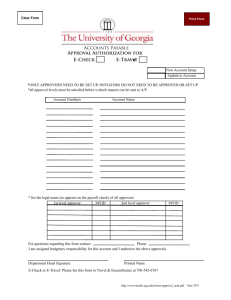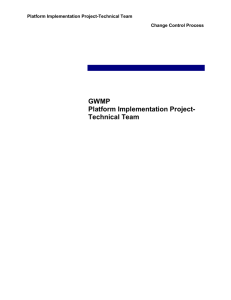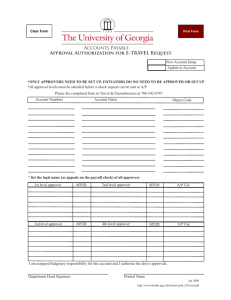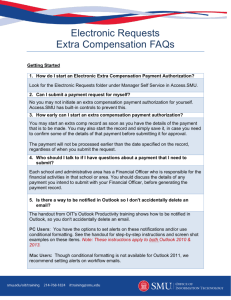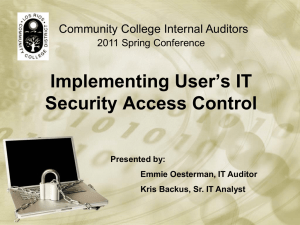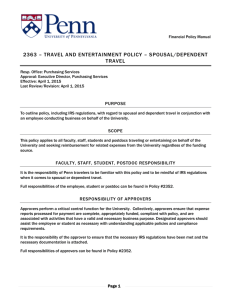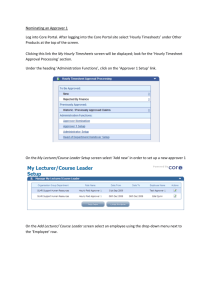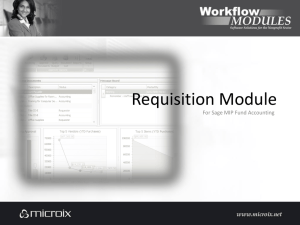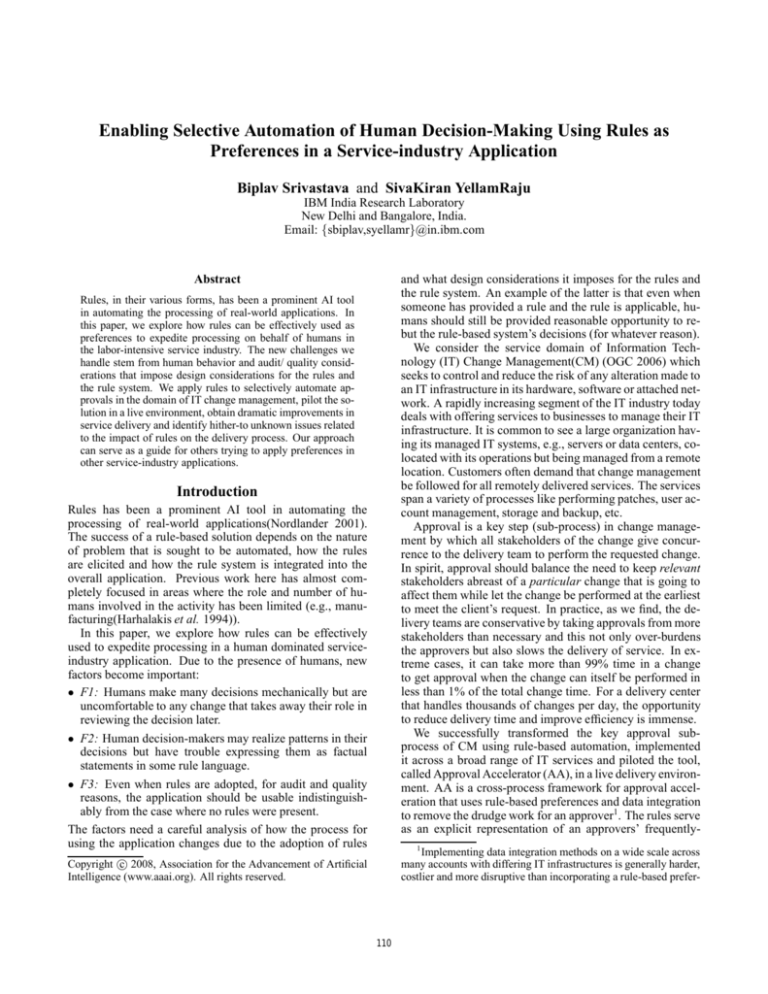
Enabling Selective Automation of Human Decision-Making Using Rules as
Preferences in a Service-industry Application
Biplav Srivastava and SivaKiran YellamRaju
IBM India Research Laboratory
New Delhi and Bangalore, India.
Email: {sbiplav,syellamr}@in.ibm.com
and what design considerations it imposes for the rules and
the rule system. An example of the latter is that even when
someone has provided a rule and the rule is applicable, humans should still be provided reasonable opportunity to rebut the rule-based system’s decisions (for whatever reason).
We consider the service domain of Information Technology (IT) Change Management(CM) (OGC 2006) which
seeks to control and reduce the risk of any alteration made to
an IT infrastructure in its hardware, software or attached network. A rapidly increasing segment of the IT industry today
deals with offering services to businesses to manage their IT
infrastructure. It is common to see a large organization having its managed IT systems, e.g., servers or data centers, colocated with its operations but being managed from a remote
location. Customers often demand that change management
be followed for all remotely delivered services. The services
span a variety of processes like performing patches, user account management, storage and backup, etc.
Approval is a key step (sub-process) in change management by which all stakeholders of the change give concurrence to the delivery team to perform the requested change.
In spirit, approval should balance the need to keep relevant
stakeholders abreast of a particular change that is going to
affect them while let the change be performed at the earliest
to meet the client’s request. In practice, as we find, the delivery teams are conservative by taking approvals from more
stakeholders than necessary and this not only over-burdens
the approvers but also slows the delivery of service. In extreme cases, it can take more than 99% time in a change
to get approval when the change can itself be performed in
less than 1% of the total change time. For a delivery center
that handles thousands of changes per day, the opportunity
to reduce delivery time and improve efficiency is immense.
We successfully transformed the key approval subprocess of CM using rule-based automation, implemented
it across a broad range of IT services and piloted the tool,
called Approval Accelerator (AA), in a live delivery environment. AA is a cross-process framework for approval acceleration that uses rule-based preferences and data integration
to remove the drudge work for an approver1. The rules serve
as an explicit representation of an approvers’ frequently-
Abstract
Rules, in their various forms, has been a prominent AI tool
in automating the processing of real-world applications. In
this paper, we explore how rules can be effectively used as
preferences to expedite processing on behalf of humans in
the labor-intensive service industry. The new challenges we
handle stem from human behavior and audit/ quality considerations that impose design considerations for the rules and
the rule system. We apply rules to selectively automate approvals in the domain of IT change management, pilot the solution in a live environment, obtain dramatic improvements in
service delivery and identify hither-to unknown issues related
to the impact of rules on the delivery process. Our approach
can serve as a guide for others trying to apply preferences in
other service-industry applications.
Introduction
Rules has been a prominent AI tool in automating the
processing of real-world applications(Nordlander 2001).
The success of a rule-based solution depends on the nature
of problem that is sought to be automated, how the rules
are elicited and how the rule system is integrated into the
overall application. Previous work here has almost completely focused in areas where the role and number of humans involved in the activity has been limited (e.g., manufacturing(Harhalakis et al. 1994)).
In this paper, we explore how rules can be effectively
used to expedite processing in a human dominated serviceindustry application. Due to the presence of humans, new
factors become important:
• F1: Humans make many decisions mechanically but are
uncomfortable to any change that takes away their role in
reviewing the decision later.
• F2: Human decision-makers may realize patterns in their
decisions but have trouble expressing them as factual
statements in some rule language.
• F3: Even when rules are adopted, for audit and quality
reasons, the application should be usable indistinguishably from the case where no rules were present.
The factors need a careful analysis of how the process for
using the application changes due to the adoption of rules
1
Implementing data integration methods on a wide scale across
many accounts with differing IT infrastructures is generally harder,
costlier and more disruptive than incorporating a rule-based prefer-
c 2008, Association for the Advancement of Artificial
Copyright Intelligence (www.aaai.org). All rights reserved.
110
made, routine decisions and captures his approval preferences. Note that the approver may be aware of his preferences or it can be learnt from his historical performance. We
anticipate approvers to be most comfortable providing preferences for low-risk decisions but they can still rebut system
decisions based on those preferences if they so choose. Consequently, AA focuses the approvers’ attention on high-risk
and skill-based decisions. We piloted AA in a live delivery
environment with about 150 servers for a month and applied
to a majority of its changes. AA lead to up to 93% reduction
in effort and 44% reduction in end-to-end duration for the
changes. The encouraging results are being applied to more
IBM delivery centers and helping in guiding new features
in IBM’s system management tools that support rule-based
automation (Tivoli).
Our contributions are:
Change
Creation
Time
Service
Order
Received
Change
Close Time
Approvals
Requested
Time of Approval
All Approvals Change
Scheduled
Gained
Start
Service
Change
ImplementationOrder
Completed
Completed
Figure 1: Stages of a change and the time line.
There are many rule formats of which the simplest are IfThen-Else and Event-Condition-Action (ECA) rules. Here,
a detailed list of events and/or conditions is recorded along
with the appropriate prescribed actions. During runtime, a
rule engine will verify the rule triggers and take the stipulated action. We use the ABLE rules system(Bigus et al.
2002).
• We explore the issues of using rules in human-dominated
applications. The key issues are how can the application
prove that the right rules were used by the application in
the right situation, when should the human approver’s attention be sought in approval, escalation or revocation,
and how can one still devise rules that are effective.
Illustration of an IT Process
Table 1 shows the near-reality patch process managed by
a remote service delivery team. Such a process description, or process model, consists of the activities involved
at each step, the roles involved with the activities, the data
items needed to process a step, the data generated and the
tools used. Now suppose we want to know what steps in
this process can be cost-effectively streamlined through rulebased automation and upto what level. A framework like
Autoseek(Srivastava 2007) can help select steps which are
good automation candidates based on their importance in
the process, the types of their information processing, and
the effort needed to elicit, write and validate the rules.
• We identified the hither-to unknown situation that if one
does not limit the minimum time duration between when
an approval is requested and the change is scheduled, a
change for which a rule is applicable can be triggered and
the change performed without giving the approver sufficient time to rebut system’s decision on her behalf.
• We show how rules as preferences was successfully used
for selectively automating approval in IT change management through a case study in a live environment.
Problem and Challenges
Approval in Change Management
In the remainder, we first give a background of rule
processing and IT change management. We analyze the
problem of seeking (and giving) approvals for changes in delivery centers and illustrate how AA seeks to address them.
We then discuss our solution to using policy-based selective
automation of human approvals and present the AA tool.
Next we explain the pilot study in a live delivery environment and conclude. More details are in the longer version at
(Srivastava & YellamRaju 2008).
In a typical CM process (e.g., Table 1), a change request
is received by a Change Manager (CM) and assigned to a
Change Implementer (CI). Approval is a key step (or subprocess) of CM by which all stakeholders to a change give
concurrence to the change (e.g., Step 8 in Table 1). No
change can go ahead without all approvals in place. The CI
will initiate requests for approval specifying the reason for
change, technical details and when it is planned, and wait till
all the approvals are obtained. In practice, the approvers are
divided into a small primary group whose approval must be
taken even in an emergency, and a larger secondary group
whose approval can be delayed during emergency but must
be still taken after a change implementation. Regardless of
how the approvals were obtained, all approvals have to be
documented for audit reasons. After getting approvals, the
change is started at scheduled time, implemented and completed.
We were looking at the problem of how to improve the
time and effort taken to perform changes in delivery centers. It was anecdotally known that acquiring approval was
problematic in many processes and accounts. We set out
to systematically understand the problem through profiling
of sample processes and their data analysis, and interviewing a wide set of practioners. We had access to many types
of processes (e.g., software installation, account-id creation,
Background
Rules as an Approach for Automation
A rule is a declarative specification of behavior that is desired from an agent. Rules are also popularly called business rules today2 or policies. There is an active research
community in AI investigating issues related to rules management (Uszok et al. 2004; Myers et al. 2002) and in application areas like IT system management(Kephart 2005;
Verma 2001) on how to use them for specific scenarios.
There are even off-the-shelf tools like Tivoli3 which support
industry-strength rule-based system management.
ence system integrated with CM tools. Hence, the focus of the AA
prototype and pilot was mostly on rules.
2
http://en.wikipedia.org/wiki/Business rules engine
3
http://www.ibm.com/software/tivoli/
111
Step No. and Name
People
Role
Action
Type
Data Needed
Date Generated
Tool(s)/ Database(s) Used
Specific To?
1. PAR Notification
2. Patch Relevance
ST
CI
C
I
Operating system
Operating system
4. Check for Patch Dependence
& Schedule Approval
CM
CI
CM
CI
Email notification
Applicable
information
CMR
Lotus Notes
3. Create CMR
S or C
N/A
Server Information,
PAR No.
Server Information,
PAR No.
PAR No.
5. Download Patch and Test
CI
S or C
PAR No.
6. Upload patch package
7. Build Change
CI
CI
S
C
PAR No.
Technical details
of patch
8. Get Customer Approval
9. Implement change
10. Propose to Close
CM
CI
CI
S or C
S
S
11. Close Change
CM
I
12. Close PAR
ST
I
S
Pre-requisites,
co-requisites,
post-requisites
Patch download
ManageNow, CPMA,
Remedy
Patch site
(Microsoft, IBM ftp site)
Patch site
(Microsoft, IBM ftp site)
Patch package
Patch package
Implementation
successful?
Verification with
customer
CMR
Server Hotfix
update
Customer specific
Operating system
Operating system
ManageNow/ CPMA
Operating system
Change and Customer
ManageNow/ CPMA
Terminal Services
ManageNow/ CPMA
Customer
Customer
Customer
ManageNow/ CPMA
Patch Notification System
Table 1: A patch process at an example service delivery center.
• Many approval requests were of little concern to the approvers. On the other hand, approvers would have to make
efforts to find changes with major impacts.
hardware installation, patching) in different delivery accounts at IBM. We also could interview Service Coordinators and Change Implementers from a wide cross-section
of accounts with differing characteristics - e.g., internal v/s
commercial, different regions, using different tools.
• The main reasons for delayed approval were:
– Data fields in the Change Record would be incorrect or
missing. Example: change details, approvers, category,
etc.
– There would be conflict in the proposed schedule or
resource used for change
– An approver’s technical or business concerns about the
change was not addressed or documented in the Change
Record
Profiling
The aim of profiling was to know the accurate time taken by
humans to perform the different steps of a process and also
estimate periods when the request was waiting between the
steps. The information would not only let us understand the
bottlenecks in a process but also help us evaluate how good
any solution that claims to remove bottlenecks is (or does it
merely transfer them to some other step?). We built a portalbased profiling tool that showed only relevant process steps
to each role player. The practioner had to click a button to
indicate that the corresponding step is initiated or completed.
The time stamps of the clicks for all changes is stored in a
central database and later queried appropriately for further
analysis.
We took the following approach to understand the approval problem and AA solution using profiling.
1. Validate an account based on changes raised and types of
processes covered in a period.
2. Profile the selected existing processes in the account
3. Insert AA (discussed later) into the account for approval
in the selected processes
4. Compare (2) and (3) and quantify the results
Illustration of AA Usage
Before we present the solution, we illustrate how AA can accelerate approval using policies and the intricacies involved.
There are many aspects that need to be taken while approving a change. As a simplified example, we now focus on
a single aspect of approval – the time at which the change
should be done. Suppose the change is needed as per the
patch process presented earlier and in a given account, there
are three approvers: the administrative owner/ user of the
server (asset), the dedicated on-site support personnel and
the account manager (see Figure 2). Let the owner be a person using the server from 9am-noon and 2pm-6pm. Let the
on-site support window be from 9am-9pm but a lunch break
is permitted from 1-3pm. The account manager does not
care when a change is done as long as all steps are followed.
In this simplistic scenario, in the current practice, the
Change Manager will seek approval from each of the three
approvers with a proposed time, and even if one of them
refuse, he has to find a new time slot and then seek approvals from all of the approvers again. The unsuccessful
approval cycles depend on the order in which approvers are
approached as is clear in Figure 2.
However, it is usually the case that all approvers are not
equally sensitive about the time of change. They may be able
to express them as rules, as illustrated in Figure 3, or we can
detect such patterns from their history of giving approvals.
It is important to note that past history is not a predictor of
what an approver may do on a particular change, but only a
Observations
While the benefit of profiling is that we get accurate measurements, the activity is time consuming. We tried to
increase the coverage of our analysis by orders of more
processes and accounts by conducting interviews of delivery
practitioners. We found that the two complementary forms
of analysis were consistent in highlighting approval as a bottleneck and the possible reasons. We found that:
• Gaining approval from internal teams could take anywhere from 10% - 80% time of the whole time to serve
a change request. In pathological cases, more than 99%
of service time could be wasted on trying to get approvals.
112
Proposed Change Duration = 2 hours
Asset Owner
(9-6 guy!!)
Busy
Busy
9am
Busy
Busy
12
Busy
3pm
Busy
Time of Approval
Busy
6pm
Dedicated Support
(9-9 support!)
Service
Order
Received
Lunch
9am
3pm
6pm
3pm
6pm
Populate CR
with Existing
Information
[Use Preapproval];
Account Manager
(Doesn’t care!)
9am
12
Figure 2: The schedules of approvers in the example change
and their next free times (circled). The change can be done
at 6pm.
Selective Approvals
Requested Based on
Policies
[Why approval needed,
What will be done,
When, How]
All
Approvals
Gained
…
Figure 4: Modified stages of change with AA.
Server
Account
Patch ID
1
Patch CMR
Builder
Policy-based Approval
Enabler (PAE)
UI
Roles:
Service
Manager
good indicator. So, the approver should retain the flexibility
to revoke any decision made with a subscribed rule for a
particular change.
CMR Record
Policy Engine
2
Server
List
APAR
+ Patch
3
Account
Information
Delivery
People
Profile
Server
Calendar
Approvers’ list:
4
Automation
Rules
Groups whose
approvals have to be
solicited and their
change windows;
Groups whose
approvals could be
automatically
determined
Figure 5: AA architecture; data flow is marked.
P1: I give pre-approval for any security-related mandatory change
that is after 6pm
If (changeType == ”IGA-Mandatory” and changeTime ≥ 1800)
result = ”yes”
P2: If there is a low-risk suggested change not requiring a reboot,
please make the change without bothering me. But please document it.
If (changeType == ”IGA-LowRisk” and needsReboot == ”no”)
result = ”yes”
P3: If a change is initiated by me, please involve me at the time of
the change to ensure that it is done as I want it
If (changeType == ”UserInitiated”)
result = ”no”
In AA, we take a two-pronged approach as shown in
Figure 4. We pre-fill most of CR fields with all relevant
and available process details before the time approvers need
them via data integration from multiple sources. We allow
approvers to subscribe to rules that reflect their concerns
about the change and use the rules to process the approval.
Note that implementing data integration methods on a wide
scale across many accounts with differing IT infrastructures
is generally harder, costlier and more disruptive than incorporating a rule-based preference system integrated with
CM tools. Hence, the focus of the AA prototype and pilot
was mostly on effectiveness of rules as approver preferences
even though data integration is the preferred mechanism to
achieve it.
Figure 3: Choice of example policies for the asset owner.
Suppose the asset owner subscribes to rule P1. AA would
record such a preference and when the Change Manager will
seek approvals, the system will use the rule in proposing the
likely time of change. The asset owner will still be notified
that a change is being made but now, the notification will
not be a request for approval but an information. It will also
include a provision to revoke the decision (here, i.e., the time
of change) resulting from the subscribed rule.
As a result of AA, here rules become a concrete representation of an approver’s scheduling constraints where none
existed before. Although incomplete, the constraints allow
the Change Manager to request for approvals with more relevant information. In the example, a simple schedule comparator can detect that 6pm is the first common time that is
free for all approvers and should be proposed.
The benefit of AA will be felt if unsuccessful approval
requests and subsequent unsuccessful cycles are reduced. To
do so, we should get more primary approvers to subscribe to
meaningful rules so that there is little or no revocation of the
decision later.
Data Integration
For pre-filling a CR related to patches, in AA, we need
to integrate data about Servers (e.g., server names, IP addresses), Account Information (e.g., SLA), Delivery Personnel (e.g., contact details) and the process information (e.g.,
Patch number and details for patches). There are two novel
features in the AA system. To enable rule-based automation,
we introduced rules as a data source in the system. Moreover, to simplify change scheduling which is a major source
of conflict, we introduced the notion of having a calendar for
each IT resource and included its schedule as a data source.
Now, given a change request (see Figure 5), the data from
the repositories are retrieved and aggregated, consistency of
schedules is checked and rules evaluated to determine the
final CR. With this, only approvers whose decisions could
not be determined for the raised change are bothered, and
for the rest, the system informs about processed decisions.
Solution Approach
IT services are delivered using a combination of process,
skilled people and technology, and these are also the parameters which can be varied to address any delivery problems. We wanted to tackle approval delays using rule
technology in a manner that it can be applied to existing
processes and available personnel.
Specification and Usage of rules
With rules, we want to capture any patterns or preferences,
whether desirable or undesirable, that the approvers can give
about the changes. The rules can encode resource conflicts,
technical or business concerns about a change like:
113
Pilot Evaluation and Experience
• the approver’s (or his applications’) relationship with the
proposed change
Our objective was to evaluate the impact of using the AA
approach in a live environment and understand the likely issues. We present the pilot results of AA in an account, the
estimation of the likely savings for delivery centers and the
overall learnings.
• preference about when to do change in his environment
• preferred mode of communication about the change
We earlier noted that humans should be allowed to rebut
any decision taken on their behalf using rules. This raises
the question about when can an automated decision be activated. An approver’s decision for a change is automatically
determinable if:
Piloting AA in an Account and Measuring the
Impact
We looked at an account with 150 servers+ for a month.
The AA system supported IT process covering 95% of the
changes in that account – patching, hardware and software
changes and user management. There were an average of 3
approvers for any change in these processes of which 1 was
the primary approver. For the servers in the account, there
were about 51 unique primary approvers. Our focus with
rules was the primary group.
We wanted to evaluate two types of metrics: efficiency,
whereby one measures the effort (e.g., time, cost) spent in
giving approvals, and effectiveness, whereby one measures
the performance (e.g., end-to-end duration) as seen by a customer. Efficiency is affected by the approver who has to
process (gets impacted) the most to give the approval. Usually, he is in the primary approver group. Effectiveness is
affected by the approver who is tardiest in giving approvals.
In the pilot, though we can directly impact efficiency of primary approvers, we may not be able to control effectiveness
since it could be caused from secondary approvers as well.
We used the profiling tool discussed earlier to collect information about the time taken to approve a change by approvers and the end-to-end time of the change, both before
and after the AA system. We had a list of 25 rules that the
primary approvers could subscribe to. The rules were acquired from our interviews of approvers and delivery personnel in the pilot account and others as well. We explained
the rules available to all the primary approvers but only 10%
of them subscribed to some rule. We used 4 default rules
to make suggestions when no user role was available (either
applicable or subscribed).
We found from the pilot that there was:
1. She has subscribed to a rule for that type of change, AND
2. A rule engine determines that that rule applies for the new
change being proposed, AND
3. The approver has not refuted the proposed change until
the scheduled start of change
01. Process Change Request
02. ServerList ← List of Servers in the request
03. ApproverList ← List of Distinct Technical Owners (Approvers)
04. Schedule the Change Based on resource calendars & ApproverList
05. For each Approver ’A’ in ApproverList
06.
If A.subscribedRules is NOT null then
;; Approver has subscribed to a rule
07.
Process the change for A.subscribedrules
08.
If result is yes for some rule ’P’ then
09.
Result ← ”YES(P)”
10.
Generate Email and Send but approver’s response
is not required to make the change
11.
Else
12.
Result ← N/A (No pre approval)
13.
Send email asking for approval
14.
Else
;; Attempt to learn by proposing a default rule
15.
Process the change using DefaultRules
16.
If result is yes for some rule ’P’ then
17.
Result ← ”Default-YES(P)”
18.
Send email asking for approval mentioning the application of
the default rule as FYI.
19.
(Analyze the user’s response over a period of time and
make suggestions
20.
Else
;; The situation without AA
21.
Result ← N/A (No pre approval)
22.
Send email asking for approval
Figure 6: The pseudo-code of AA.
Figure 6 shows how rules can be used to automate approvals during CM. There are two main cases: an approver
has either subscribed to a set of rules or not. In the former
case, the current change record is evaluated to see if any of
the subscribed rule matches. If yes, the system already has
a pre-approval from this approval and an appropriate email
informing the decision taken is sent as a notification. Otherwise, none of the subscribed rules match, and the approver
has to be conventionally requested for his/her approval. In
the latter case, we can attempt to learn rules. We define a
default set of rules unknown to the approvers and evaluate
a change based on them. The result is a suggestion and
sent to the approver in the initial approval request e.g., as
a scheduled start time. If the approver accepts the suggestion, we have been able to learn one instance of the user’s
preference. These instances can be aggregated via different
learning schemes to derive candidate rules. Note that we are
merely trying to intelligently request for approval but have
to wait until the approver gives her decision. The current
process, which is what happens if no default rules are used,
requests for approvals blindly and waits.
• Efficiency - effort in giving approval
– There was 80% savings across all processes measured
on a time basis
– When savings are measured based on the salary of individual approver groups, the saving show as ≥ 93%
across all processes.
• Effectiveness: end-to-end duration
– The savings was 44% for patching
– The savings was ≤ 5% for other processes
During the pilot period, patching was the dominant
change in the account. No approver who had subscribed
to a rule refuted its decision during the pilot. Surprisingly,
we also found that while default rules were used in suggestions to primary approvers in 85% of the changes, there was
no refutation of it. While we do expect rules to be refuted
by approvers and more so when they have not subscribed to
114
customer, and then closely monitored by all. With AA, this
duration has to be brought into SLAs for all processes wherever the customer is among the primary approvers.
them, the pilot experience does indicate that there are good
rules which broadly capture approvers’ preferences.
The results were very encouraging. Recall that the efficiency is impacted by rules while the effectiveness was not
in control of the primary approvers. We also did a user survey of the approvers to gauge their experience. Results from
surveys show that they:
Conclusion
We looked at how rules can be effectively used to expedite
processing in a human dominated service-industry application. The key principles in AA are: allows humans the opportunity to rebut decisions resulting from rules that they
may have subscribed, exercise default rules to learn implicit
rules that the humans can later ratify, and incorporate rules
as a data source that is processed while data is being integrated in the change system. We did a controlled pilot and
got encouraging results that we estimate can be generalized.
The learnings are being applied to more IBM delivery centers and helping in guiding new features in IBM’s system
management tools that support rule-based automation.
We believe the AA approach can serve as a guide for others trying to simplify and automate human decision making
using preferences in other service-industry applications as
well.
• want help to reduce time spent on approvals
• can provide patterns of desirable changes (rules) and AA
captured many of them
• did not feel that mere integration of data will improve
their approval productivity
Estimating impact of AA in a delivery center
With the pilot, we had results from a controlled experiment.
We also estimated the scope of savings possible for a large
delivery center. In doing so, we had to consider that the typical number of approvers for a change can vary anywhere
from 3 to 10 of which the primary approvers can be from
1-4. Finding patterns/ obtaining rules for primary approvers
is time-consuming and difficult but if obtained, the rules can
be very effective in reducing the efforts of rest of the approvers. Finding rules for secondary approvers is easier but
lesser effective in increasing savings since they usually try
to accommodate decisions of primary approvers.
We estimated that for large delivery centers, where there
is a large diversity of accounts and IT processes, obtaining
up to 50% savings in effort (measured on time basis) and
up to 20% savings in end-to-end duration from preferences
captured as rules is feasible. We also note that while data
integration emerged as an issue in our problem analysis, it
is not factored in our estimates. Hence, the possible savings
could be even higher if a standardized approach towards data
integration across accounts is taken.
References
Bigus, J.; Schlosnagle, D.; J. Pilgrim, J.; Mills, W.; and
Diao, Y. 2002. Able: A toolkit for building multiagent
autonomic systems. In IBM Sys. Jour., Vol. 41, No. 3.
Harhalakis, G.; Lin, C. P.; Mark, L.; and Muro-Medrano,
P. R. 1994. Implementation of rule-based information systems for integrated manufacturing. IEEE Trans. on Knowl.
and Data Eng. 6(6):892–908.
Kephart, J. O. 2005. Research challenges of autonomic
computing. In ICSE ’05: Proc. 27th Intl. Conf. Software
Engg., 15–22. New York, NY, USA: ACM Press.
Myers, K. L.; Tyson, W. M.; Wolverton, M. J.; Jarvis,
P. A.; Lee, T. J.; and desJardins, M. 2002. Passat: A
user-centric planning framework. Proc. 3rd Int’l NASA
Workshop Planning and Scheduling for Space. At citeseer.ist.psu.edu/myers02passat.html.
Nordlander, T. E. 2001. AI surveying: Artificial intelligence in business. MS Thesis, De Montfort University. At
http://www.4c.ucc.ie/web/upload/publications/mastersThesis
/Artificial Intelligence in Business.pdf.
OGC. 2006. IT infrastructure library (ITIL ). In
http://www.itil.co.uk/.
Srivastava, B., and YellamRaju, S. 2008. Enabling
selective automation of human decision-making using rules as preferences in a service-industry application. IBM Research Report RI08007. Available from:
http://domino.research.ibm.com/library/cyberdig.nsf/index.html.
Srivastava, B. 2007. Autoseek: A method to identify candidate automation steps in IT change management. In Proc.
Intelligent Management (IM-2007), Munich, Germany.
Uszok, A.; Bradshaw, J. M.; Johnson, M.; Jeffers, R.; Tate,
A.; Dalton, J.; and Aitken, S. 2004. Kaos policy management for semantic web services. IEEE Intelligent Systems
19(4):32–41.
Verma, D. C. 2001. Policy-based networking: Architecture
and algorithms. In New Riders Pub., ISBN: 1-57870-226-7.
Learnings from AA
The implications of using rules to supplement human
decision-making are:
1. The rules subscribed by each approver at any given time
should be known.
2. The life cycle of each rule available in the system has
to be tracked and managed until it is obsoleted so that
provenece of rules is known for audit.
3. The minimum duration between when the approval is
raised and when the change is scheduled has to be prominently highlighted.
The last implications is very important if rules have to be
used for automating human decision making and is largely
unknown. Recall from previous section that the third condition for determining approver’s concurrence is that there is
no rebuttal during this period. But if the period is arbitrarily
short, the approvers would not be able to rebut. How do we
put a minimum limit and highlight it?
The answer is Service Level Agreements (SLAs). SLAs
are contractual documents recording the performance criteria promised by a IT services delivery organization and its
115

